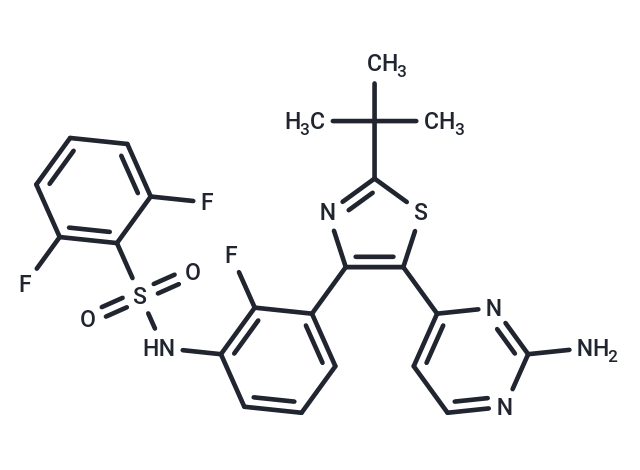Shopping Cart
- Remove All
 Your shopping cart is currently empty
Your shopping cart is currently empty

Dabrafenib (GSK2118436A) is a Raf inhibitor that inhibits C-Raf and B-RafV600E (IC50=5/0.6 nM) and is ATP-competitive. Dabrafenib exhibits antitumor activity for the treatment of B-RafV600E-mutated melanoma.

| Pack Size | Price | Availability | Quantity |
|---|---|---|---|
| 5 mg | $41 | In Stock | |
| 10 mg | $57 | In Stock | |
| 25 mg | $72 | In Stock | |
| 50 mg | $85 | In Stock | |
| 100 mg | $117 | In Stock | |
| 200 mg | $158 | In Stock | |
| 1 mL x 10 mM (in DMSO) | $46 | In Stock |
| Description | Dabrafenib (GSK2118436A) is a Raf inhibitor that inhibits C-Raf and B-RafV600E (IC50=5/0.6 nM) and is ATP-competitive. Dabrafenib exhibits antitumor activity for the treatment of B-RafV600E-mutated melanoma. |
| Targets&IC50 | B-Raf (V600E):0.7 nM (cell free), B-Raf:5.2 nM (cell free), C-Raf:6.3 nM (cell free) |
| In vitro | METHODS: 195 tumor cells were treated with Dabrafenib for 72 h. Cell growth was detected using the CellTiter-Glo Assay. RESULTS: Sixteen of the 20 cell lines encoding BRAFV600E were sensitive to Dabrafenib (gIC50<200 nM). Three of the other five mutant BRAF cell lines were sensitive to Dabrafenib (gIC50<30nM), including WM-115 (BRAFV600D) and YUMAC (BRAFV600K). 133 of 152 RAS/RAF wild-types and all 18 mutant RAS cell lines were insensitive to Dabrafenib (gIC50>10µM). gIC50>10µM). [1] METHODS: Melanoma cell lines LCP (BRAFV600R), WM266 (BRAFV600D) and M257 (BRAFWT) were treated with Dabrafenib (3-100 nM) for 72 h. Target protein expression levels were detected using Western Blot. RESULTS: Cell lines with the BRAFV600D/R mutation exhibited faster and stronger inhibition of phosphorylated ERK compared to control cells with wild-type BRAF. [2] |
| In vivo | METHODS: To assay antitumor activity in vivo, Dabrafenib (3-100 mg/kg, 0.5% hydroxypropylmethylcellulose+0.2% Tween 80 in pH 8.0 distilled water) was administered by gavage to human colorectal cancer tumor-bearing Colo 205 ( BRAFV600E) CD1 nu/nu mice once daily for fourteen days. RESULTS: Dabrafenib showed dose-dependent inhibition of tumor growth, with four of eight mice showing partial regression at a dose of 100 mg/kg. [1] METHODS: To test the antitumor activity in vivo, Dabrafenib (0.1-100 mg/kg, 0.5% hydroxypropylmethylcellulose+0.2% Tween 80 in pH 8.0 distilled water) was administered by gavage to mice harboring human malignant melanoma A375P F11 ( BRAFV600E) CD1 nu/nu mice once daily for fourteen days. RESULTS: Dabrafenib significantly reduced tumor growth in mice bearing B-RafV600E human melanoma tumors. complete tumor regression was observed in 50% of treated animals in the 100 mg/kg group. [3] |
| Cell Research | A375P-F11 assay: A375P cells were plated in 96-well plates by limiting dilution and single cell-derived clones were harvested and tested for sensitivity to B-Raf inhibitors. The F11 clone was selected for future studies and was named A375P-F11. Cellular pSmad Assay to Measure Anti-TGF-β Activity: Activity of compounds was tested in a mechanistic assay in HepG2 cells. Cells were seeded in 12-well plates at a density of 500,000 cells/well and allowed to adhere overnight at 37℃/5% CO2. Media (BME+10% serum) was removed and compound in serum-free media was added to the cells for 45 minutes at 37℃/5% CO2. Cells were stimulated with 1 ng/ml TGF-β for 60 minutes. Cells were lysed in buffer (25 mM Tris-HCl ph: 7.5, 2 mM EDTA, 2 mM EGTA,1% Triton X-100, 0.1 % SDS, 50 mM sodium-β-glycerophosphate, 2 mM sodium orthovanadate, 12.5 mM sodium pyrophosphate, protease and phosphatase inhibitor cocktails) for 30 minutes, scraped, collected, clarified by centrifugation and prepared for western blots in LDS/reducing reagent. Samples were resolved on 4-12% Bis-Tris gels, transferred to PVDF, and probed for total and phospho-Smad2 using antibodies. Gels were imaged using the odyssey blot scanner and quantified. Phospho:total Smad2 ratios were determined and the IC50 was defined as the concentration of compound which decreased the phospho:total ratio by 50% [1]. |
| Animal Research | Cells were implanted in nude mice and grown as tumor xenografts. Dosing began when tumors achieved ~150-200mm^3 volume. GSK2118436 was administered by oral gavage at a dose volume of 0.2 mL/20 gram body weight in 0.5% hydroxypropylmethylcellulose and 0.2% Tween-80 in distilled water pH 8.0. Dosing was daily for duration stipulated. Results are reported as mean tumor volume for n=7-8 mice/group. Tumors were measured twice weekly with Vernier calipers, and tumor volume was estimated from two-dimensional measurements using a prolate ellipsoid equation (Tumor volume mm^3 = (length x width^2) x 0.5). Complete tumor regression was defined as a >93% decrease in an individual tumor volume for at least 1 week [1]. |
| Alias | GSK2118436A, GSK2118436 |
| Molecular Weight | 519.56 |
| Formula | C23H20F3N5O2S2 |
| Cas No. | 1195765-45-7 |
| Smiles | CC(C)(C)c1nc(c(s1)-c1ccnc(N)n1)-c1cccc(NS(=O)(=O)c2c(F)cccc2F)c1F |
| Relative Density. | 1.443 g/cm3 |
| Storage | Powder: -20°C for 3 years | In solvent: -80°C for 1 year | Shipping with blue ice. | |||||||||||||||||||||||||||||||||||
| Solubility Information | Ethanol: < 1 mg/mL (insoluble or slightly soluble) DMSO: 55 mg/mL (105.86 mM), Sonication is recommended. | |||||||||||||||||||||||||||||||||||
| In Vivo Formulation | 10% DMSO+40% PEG300+5% Tween 80+45% Saline: 2.8 mg/mL (5.39 mM), In vivo: Please add the solvents sequentially, clarifying the solution as much as possible before adding the next one. Dissolve by heating and/or sonication if necessary. Working solution is recommended to be prepared and used immediately. Please add the solvents sequentially, clarifying the solution as much as possible before adding the next one. Dissolve by heating and/or sonication if necessary. Working solution is recommended to be prepared and used immediately. The formulation provided above is for reference purposes only. In vivo formulations may vary and should be modified based on specific experimental conditions. | |||||||||||||||||||||||||||||||||||
Solution Preparation Table | ||||||||||||||||||||||||||||||||||||
DMSO
| ||||||||||||||||||||||||||||||||||||

Copyright © 2015-2025 TargetMol Chemicals Inc. All Rights Reserved.